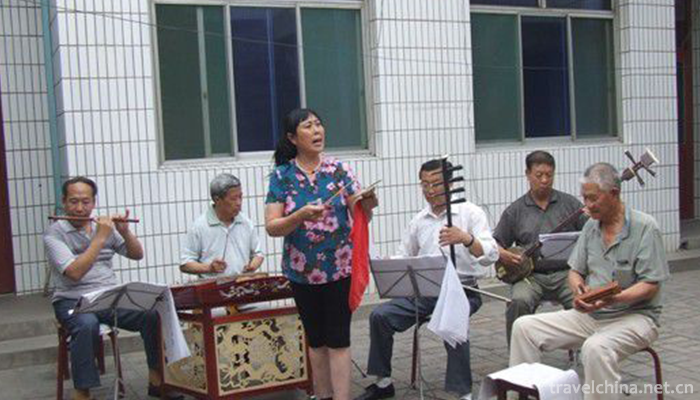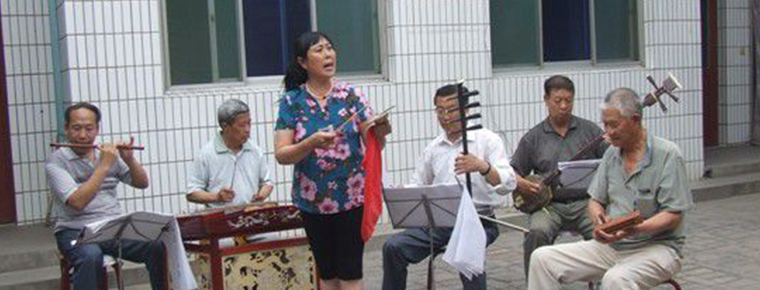Quwoqin Books
Quwoqin Books
Quwo Qinshu is a kind of local traditional folk art form which was formed and mainly popular in Quwo County in the south of Shanxi Province and its adjacent areas of Shanxi, Shanxi and Henan provinces. Because of the alternate rhythm accompaniment of octagonal drum and cymbal, it was formerly called "Drum Book" or "Hinge Book". It is generally believed that during the Daoguang period of the Qing Dynasty, "Yue Diao" (also known as "Moon Diao"), introduced from Nanyang, Henan Province, evolved in combination with local dialects and minors. It has a history of about 130 years.
On May 23, 2011, the Quwo Qin Book declared by Quwo County, Shanxi Province, was approved by the State Council and listed in the third batch of national intangible cultural heritage list.
artistic characteristics
The performance form of Quwo Qinshu is rap and singing, mainly singing, using Quwo dialect. In the early period, most of the performances were accompanied by bangles in one hand, sitting and singing in Quwo dialect, self-pulling four-bearded wooden fish on foot, or one-handed playing of the violin and one-handed playing of the bangles. Later, there were many partners performing. The lyrics are mainly composed of seven-character sentences, four sentences as a paragraph, and even sentences rhyme. The aria belongs to a mixture of plate and plate. It has two kinds of aria tunes, namely "hinged chamber" and "drum chamber". The two kinds of tunes are different in pitch, so they need to be changed in alternate singing. In addition to octagonal drums, small hinges and wooden fish, accompaniment instruments can also include four hu, yangqin, banhu, three strings, flute, erhu, etc.
Current situation of inheritance
Linfen is a big city of cultural resources. In 2005, the city established the intangible cultural heritage protection center, following the guidelines of "protection first, rescue first, rational utilization, inheritance and development", after several years of hard work, "non-heritage" protection work has made breakthroughs. In this year's third batch of national intangible cultural heritage publicity list, our city has nine more lists on the list. Quwoqin is one of them.
Since the 1990s, with the death of old artists, only a few young artists still perform, with fewer inheritances, fewer performances and less influence. Their values and functions can not be fully demonstrated. They are on the verge of disappearance and need urgent rescue and protection. Nowadays, many performances of Quwoqin books only show a small part of the contents of Quwoqin books. In fact, there are many contents that can be excavated, such as its lyrics, tunes and so on. It can integrate the forms and contents of performances popular with modern peasants into traditional programs, making its performances more unique and vivid, and making Quwoqin books circulate for a long time.
In recent years, a lot of fruitful work has been done in the inheritance and protection of Quwoqin books. In addition to the establishment of Quwo County's "intangible cultural heritage protection center", which guarantees the necessary working mechanism for the protection of Quwo Qinshu, two folk Quwo Qinshu performance clubs have been organized to organize young artists to learn the performance of Qinshu, so that this ancient form of performance can be inherited and developed. Fortunately, there are always some young people in Quwo, which has thousands of years of cultural accumulation, and they still love Quwoqin books. Chang Weixin is a native Quwo. After graduating from high school in 1992, he Songqing, the uncle of Quwo County Qinshu Team, studied Quwo Qinshu performance. The performances include "Pillow Playing", "Baogong Case", "Five Girls Salute Their Birthdays", "Two Little Curses to Parents" and so on. In 2007, at the Spring Festival Literature and Art Festival in Quwo County, he won the first prize for his self-compiled Quwo Qin book "Battle Fenhe". Chang Weixin now sells cosmetics in Gaoxian Town of Quwo. But whenever there was a performance of Quwoqinshu, she would put down her business and go out to perform. When it comes to the inheritance and protection of Quwoqin books, Chang Wei-xin has his own worries: life is getting better and better, people's ways of entertainment are more and more, and Quwoqin books lack innovation, singing tune, content and form are relatively single and stereotyped, and there are not many teams who can really sing excellent works, so it is difficult to adapt to the aesthetic needs of modern people. At the same time, the inheritance of Quwoqin books is scarce, so the protection work is imminent. Chang Weixin said that many performances of Quwoqin books now only show a small part of the contents of Quwoqin books. In fact, there are many contents that can be excavated, such as its lyrics, tunes and so on. It can integrate the forms and contents of performances popular with modern farmers into traditional programs, making its performance form more unique, more vivid, so that Quwoqin books can be excavated. It has been circulating for a long time.
Inheritance Significance
Quwo Qinshu's traditional programs are relatively rich. There are long books drawn from classical novels, novellas created by literati and ink writers, short books drawn from folklore and myth stories, and small book caps with humor and wit. Generally speaking, cultures deposited by history are the best cultural heritage. Quwoqin book not only has a history of more than 130 years, but also many excellent traditional programs created and developed by artists of past dynasties, which embodies the life attitude, aesthetic taste and ideal of local people. Quwoqin book is rich in historical and cultural content, and is also a fine work of local folk art.


-
1.Shishi Sacred Heart Cathedral
Guangzhou Shishi Sacred Heart Cathedral is located in Yide Road
Time 2018-10-12 -
2.Tea horse ancient road
Tea-horse ancient road refers to the folk international trade
Time 2018-10-17 -
3.Shennongjia Forestry DistrictHubei Shennongjia
Shennongjia Forest District, referred to as Shennongjia for short, was established in 1970 with the approval of the State Council and directly under the jurisdiction of Hubei Province.
Time 2018-10-28 -
4.Tiantai Mountain Scenic Area
Tiantai Mountain Scenic Spot, National AAAAA Class Tourist Spot, National Key Scenic Spot, One of China's Top Ten Famous Mountains, National Eco-tourism Demonstration Zone, Zhejiang Top Ten Tourist Sp
Time 2018-12-07 -
5.Qingxiushan scenic spot
Qingxiushan Scenic Area is a national AAAAA scenic spot in Nanning. Qingxiu Mountain is a key scenic spot in Nanning. In addition to protecting and restoring the original historic sites such as Dong Q
Time 2018-12-12 -
6.Yangba Subtropical Ecotourism Scenic Area
Yangba subtropical eco-tourism scenic spot is located in Yangba Town, south of Kangxian Town, Longnan City, Gansu Province, 84 kilometers away from the county town
Time 2019-03-02 -
7.Multi voice Folk Songs of Hani Nationality
Hani multi-voice folk songs are popular in several Hani villages in the eastern part of Azahe Township, Honghe County, with Puchun Village as the center. Their natural environment is closed and traffi
Time 2019-05-02 -
8.Huizhou folk songs
Huizhou folk song is an ancient traditional folk art in Huizhou area. It is rich in content and diverse in genres, including chants, folk songs, minors, Buddhist and Taoist songs,
Time 2019-05-04 -
9.Cork paintings
Cork painting, also known as cork carving, woodcut. Chinese traditional folk sculpture crafts. It is mainly produced in Fuzhou, Fujian Province. It is a handicraft combining carving and painting. Simp
Time 2019-06-11 -
10.Ban Zhao
Ban Zhao (about 45 years - about 117 years), also known as Ji, the word Hui ban. Fufeng An Ling (now northeast of Xianyang, Shaanxi), a historian and a writer of Eastern Han Dynasty. historian Ban Bi
Time 2019-09-11 -
11.Beijing University of Posts and Telecommunications
More than sixty years of wind and rain, more than sixty years of spring and autumn fruits. In the north of Mingguang and the south of Jimen, the ancient city walls witness the ever-lasting radio waves
Time 2019-09-22 -
12.Cross stitch of Chinese embroidery
The earliest cross stitch was embroidery on animal fur fabrics with silk extracted from silkworm cocoons. Later, it was used to decorate clothes and furniture. Cross stitch, with its simple embroidery method, noble and gorgeous appearance, exquisite
Time 2020-12-12